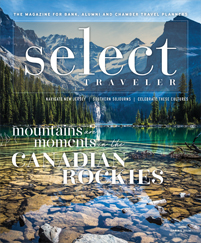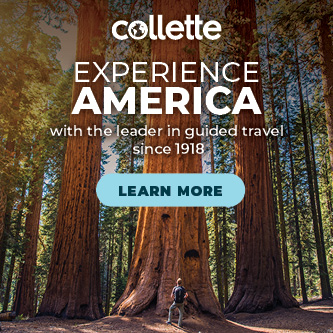Some places just look better from the seat of a bicycle.
Motorcoaches may be the traditional vehicle of choice for the group tour industry, but as tourism customers become healthier and more active, more travel coordinators are looking for inventive ways to attract travelers who wouldn’t normally be interested in sitting on a bus all day. That’s where the bicycles come in.
Bicycle vacations began as a niche activity in the 1980s, attracting athletic travelers who wanted to explore small parts of popular destinations while still burning lots of calories. In the past 30 years, these tours have grown in popularity. Several companies now offer bicycle tours in North America, Europe and even more exotic locales.
If your travel organization includes a young and active clientele, or if you’re looking to expand your audience to reach such people, consider incorporating a bicycle tour into your product offerings. Here are five keys to making a bicycle tour successful.
1) Expert help is required.
Intrepid travel planners often take normal trips into their own hands, booking the arrangements themselves instead of using the services of tour operators. For bicycle tours, though, this approach is a nonstarter. The equipment and expertise required to stage a successful bike vacation necessitates the use of a tour operator that specializes in that area.
“We provide a fully supported bike tour,” said Todd Starnes, owner of Seattle-based Bicycle Adventures. “We have the bikes, the helmets and a van to carry all your gear.”
In addition to the practical necessities of equipment and logistics, bike tour operators provide guides that specialize in helping people make the most of this style of travel. VBT, the company that began as Vermont Bicycle Tours and now operates trips worldwide, emphasizes the importance of these guides.
“Everywhere we go, we have two local, bilingual guides,” said John Zelig, the company’s group tour manager. In this configuration, one guide leads the group on a bicycle while the other drives a support van behind the group.
2) An active audience is important…
As the name implies, bicycle vacations require a measure of physical effort not necessary on a typical group tour. Because of this, they tend to attract younger, more active customers.
“We like to say that cycling is the new golf,” Starnes said. “Baby boomers are enjoying a more active lifestyle, and they want active vacations. They’re choosing the bicycle over a cruise or a sedentary vacation.
“It’s a pretty fit crowd — they like the outdoors and they go to the gym on a fairly regular basis. But cycling doesn’t have to be their thing. Sometimes, the only time people ride a bike is when they’re on a tour with us.”
Though most bike tours aren’t cycling marathons, they do involve riding between 15 and 30 miles a day. Often those rides are split up by a gourmet picnic lunch. On shorter days, guests may ride in the morning and then spend the afternoon at a winery, a spa or a popular local attraction.
3) …but all skill levels are welcome.
It would be easy to think that only athletes are attracted to cycling vacations, but operators say that’s not the case. The average age for many groups is between 65 and 70 years old, and participants don’t have to have been a cycling enthusiast to enjoy a trip.
“We have a lot of people who haven’t been on a bike in 20 years,” Zelig said. “It’s not all about the biking and walking.”
New technology is helping to make bike tours accessible to even more people. Pedal-assist bicycles, also known as e-bikes, use electric motors to help drive the wheels, allowing riders to traverse hills and other terrain with reduced effort.
“Pedal-assist bikes have given people who aren’t avid riders the ability to go on a bike tour,” Zelig said. “If your spouse is a big rider and you aren’t, your spouse can lead the pack, and you can still ride having a good time.”
4) Flexibility is a benefit.
Most traditional tours involve a detailed itinerary and a fair amount of structure to keep everything running on time as the group moves from one attraction to the next. But on bicycle tours, riding is one of the chief highlights, and a smaller group size allows guides to customize the day on the fly based on riders’ preferences.
“There’s nobody holding up a flag for you to follow,” Starnes said. “Everyone can stop whenever they want to take a picture. When we have things like wine tastings, if the group wants to linger for another couple of hours, we can do that. There isn’t a set schedule. We’re so flexible — we can start at 6 in the morning or sleep in later. We can do less biking and more hiking if people want.”
Bike tour operators still make sure that participants get to visit the major attractions in the places they visit, but they often opt for free time at those places as opposed to guided tours.
5) Immersion is the name of the game.
Motorcoaches allow groups to cover vast distances in short amounts of time. Bicycle trips, however, give riders an in-depth look at a smaller geographical area and provide immersive experiences that aren’t often possible on bigger tours.
“In the end, it’s really not about the biking,” said Laura Breen, head of VBT’s sales and customer service. “It’s about getting out and experiencing a slower pace than a motorcoach. A farmer might stop and invite them to come see the farm. It’s a very cultural experience. We like to include a focus on cultural immersion in all our trips, and having a local leader is a big part of that.”
“There are opportunities to do everything from a home-hosted meal in a village in Italy to learning how to make pastry in Slovenia,” said her colleague, Zelig. “There are little things to discover that you won’t find on a normal tour.”









